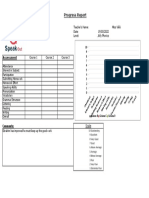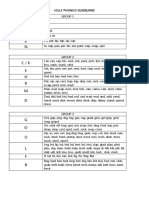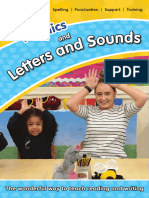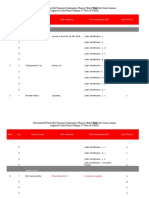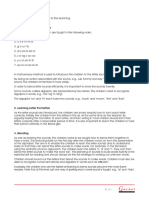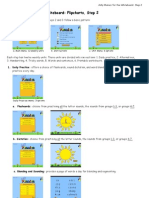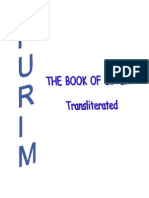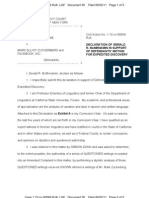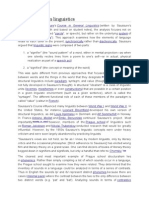Jolly Phonics
Jolly Phonics
Uploaded by
rungrungCopyright:
Available Formats
Jolly Phonics
Jolly Phonics
Uploaded by
rungrungOriginal Description:
Original Title
Copyright
Available Formats
Share this document
Did you find this document useful?
Is this content inappropriate?
Copyright:
Available Formats
Jolly Phonics
Jolly Phonics
Uploaded by
rungrungCopyright:
Available Formats
Jolly Phonics
Jolly Phonics is a phonics program that teaches children the alphabetic code of English. In the first nine weeks or so, the children are taught the 42 letter sounds, how to blend them to read words, and how to cope with the first few irregular keywords working towards becoming an independent reader.
There are five main elements to the program:
1. Learning the Letter Sounds
The main 42 sounds of English are taught one sound every day and in the Jolly Phonics order. 1. s a t i p n 2. c k e h r m d 3. g o u l f b 4. ai j oa ie ee or 5. z w ng v oo oo 6. y x ch sh th th 7. qu ou oi ue er ar A multisensory method is used to introduce the children to the letter sounds. There is a storyline, action and Sound Sheet for each sound. By doing an action associated with the sound, e.g., rub tummy and say mmmmm for the /m/ sound, the children remember it more easily. In order to blend efficiently it is important to know the letter sounds fluently. Each day at school, flash cards of the sounds that have been taught will be reviewed with the children as they call out the sounds and do the actions for each letter. This practice should be reviewed at home everyday using the letter cards in your childs homework folder. Some sounds, digraphs, are represented by two letters. The children need to recognize digraphs in words, e.g., the ng in strong. The digraphs oo and th each have two sounds, e.g., book and moon, thin and that. In Jolly Phonics they are initially written in two sizes to help the children understand that there are two sounds.
2. Learning Letter Formation
As the letter sounds are introduced, the children are shown exactly how to form each letter correctly. Initially, the children form the letters in the air, at the same time as the teacher. By regularly feeling the formation of each letter, and then writing it, most children should form their letters correctly after the first twelve weeks or so. It is also important to teach the children to hold their pencil correctly. It is important to practice this at home with your child.
3. Blending
As well as learning the sounds, the children need to be taught how to blend them together to hear a word. The aim is to enable the children to hear the word when the teacher says the sounds, e.g., Listen carefully, what word am I saying ... d-o-g? This is difficult and needs to be practiced by most children. Once the children can hear the word when an adult says the sounds, they are ready to try and blend words for themselves. Children must also be able to recognize consonant blends and digraphs in words such as fl-a-g and sh-o-p. Parents can play this game at home by saying words slowly and isolating each sound in a word. You might say, Get me the r-e-d crayon.
4. Identifying Sounds In Words
It is essential that children can hear the individual sounds in words, especially for writing. Initially, the children are asked to listen carefully and say if they can hear a given sound in words. Beginning with words that have three sounds in them, for example, Is there a s in sun ... mouse ... dog?; If there is a s where does it come the beginning, middle or end? is best. Then the children are encouraged to say the sounds they hear. Practice by saying a word like hat. The children should respond by saying h-a-t. As they say each sound they hold up a finger ... h-a-t three fingers, three 2 sounds; sh-i-p three fingers, three sounds, etc. Once a child can hear the sounds in words, and knows one way of writing each sound, they can write independently. Initially, the children will not spell accurately but their work can be read, for example, I went hors riedin that wos fun. Most children, by the end of their first year, should be able to write their own news and simple stories independently. It will be exactly what they want to say as they are not restricted by writing only the words they have learned by heart.
5. Tricky Words
After their first month or two at school, when the majority of the children know about 18 letter sounds and have been blending regular words as a group activity, they will begin to learn the tricky words. Tricky words are words that cannot always be worked out by blending. These will be introduced gradually using the Jolly Phonics Tricky Word Cards. We will look at what is tricky in each word, e.g., was has an /o/ sound in the middle instead of an /a/ sound. Words will be taught for reading and spelling.
Our goal is that through phonics instruction and practice all the children will be able to:
read and write the 42 letter sounds, form the letters correctly, holding their pencil in the tripod grip, blend regular words fluently, for example, leg, flag, shoot and bringing write simple, regular words by listening for the sounds, for example, bed, flat, band, ship and spoon.
You might also like
- Jolly PhonicsDocument7 pagesJolly Phonicsrungrung94% (16)
- Jolly PhonicsDocument4 pagesJolly Phonicsrungrung100% (10)
- Jolly PhonicsDocument12 pagesJolly Phonicsrungrung89% (9)
- Jolly Phonics LyrricsDocument4 pagesJolly Phonics LyrricsGrace WeeNo ratings yet
- Group 5 Phonics Decodable Reading CardsDocument11 pagesGroup 5 Phonics Decodable Reading CardsPrabuddh Verma100% (1)
- AnagramsDocument20 pagesAnagramsNicole HernandezNo ratings yet
- Timetables For Firwst Years With JollyDocument4 pagesTimetables For Firwst Years With Jollyglchong6690No ratings yet
- Rose ReportDocument105 pagesRose Reportgrg100% (2)
- Phonics PosterDocument10 pagesPhonics PosterEkaterina BorreroNo ratings yet
- Jolly Phonics Pupil - Student ChecklistDocument1 pageJolly Phonics Pupil - Student Checklistaviator2_2001No ratings yet
- Literacy Continuum ESL Scales and EALD October 2013Document18 pagesLiteracy Continuum ESL Scales and EALD October 2013S TANCRED75% (4)
- Operational Plan For Highly Immersive ProgrammeDocument8 pagesOperational Plan For Highly Immersive ProgrammeThaddaeus Kouta50% (2)
- Text To Speech System For KonkaniDocument6 pagesText To Speech System For Konkanivijayrebello4uNo ratings yet
- A - Jolly PhonicsDocument4 pagesA - Jolly PhonicsAnnie N0% (1)
- Parent Teacher Guide Jolly PhonicsDocument24 pagesParent Teacher Guide Jolly PhonicsIris Ellora100% (2)
- How To Use Synthetic Phonics PDFDocument3 pagesHow To Use Synthetic Phonics PDFAnonymous eynRrXPNo ratings yet
- Holiday CalendarDocument17 pagesHoliday Calendarranjeetsingh2908No ratings yet
- H - Alternative Spelling of VowelsDocument2 pagesH - Alternative Spelling of VowelsNicole HernandezNo ratings yet
- Jolly Phonics TemplateDocument1 pageJolly Phonics TemplateVIKKI BRYANTNo ratings yet
- Jolly Phonics Progression MapDocument3 pagesJolly Phonics Progression MapLao Vanessa100% (3)
- Whiteboard V3 Manual PDFDocument10 pagesWhiteboard V3 Manual PDFaishwarriyaNo ratings yet
- S A T I P N: Jolly Phonics GuidelinesDocument3 pagesS A T I P N: Jolly Phonics GuidelinesGraciaNo ratings yet
- JP Activity IdeasDocument2 pagesJP Activity Ideasbookwormj100% (1)
- Jolly Phonics Presentation Slides PDFDocument61 pagesJolly Phonics Presentation Slides PDFPooja NandakumarNo ratings yet
- 'Ai' Jolly PhonicsDocument11 pages'Ai' Jolly PhonicsLyndi ScottNo ratings yet
- Jolly Phonics Actions SheetDocument7 pagesJolly Phonics Actions Sheetapi-286756291No ratings yet
- Onset-Rime 1Document6 pagesOnset-Rime 1api-328116068No ratings yet
- Aligns With The Common Core State Standards (CCSS) From Kindergarten To Grade 5 For English Language ArtsDocument8 pagesAligns With The Common Core State Standards (CCSS) From Kindergarten To Grade 5 For English Language ArtsKhuc Huong TraNo ratings yet
- Kindergarten Trimester Assessment Common CoreDocument2 pagesKindergarten Trimester Assessment Common CoreshelliegohlNo ratings yet
- Jolly Phonics and Letters and SoundsDocument12 pagesJolly Phonics and Letters and SoundsMaram Abd El HadyNo ratings yet
- Jolly Phonics Workbook 1Document28 pagesJolly Phonics Workbook 1tsdevi2205No ratings yet
- Jolly Phonics SoundsDocument2 pagesJolly Phonics Soundsapi-306276137No ratings yet
- Basic Phonics Workshop For Year One Teachers Subis District: 19 MEI 2014 Bilik Mesyuarat Utama, Aras 2, PPD SubisDocument20 pagesBasic Phonics Workshop For Year One Teachers Subis District: 19 MEI 2014 Bilik Mesyuarat Utama, Aras 2, PPD Subisnamirullah1435No ratings yet
- Phonics Long+Medium Term PlanningDocument5 pagesPhonics Long+Medium Term PlanningLadyKentNo ratings yet
- Leading The Teaching of LiteracyDocument37 pagesLeading The Teaching of LiteracyNastjaNo ratings yet
- Jolly Phonic: Learning The Letter SoundsDocument2 pagesJolly Phonic: Learning The Letter SoundsPratiwi Surya RahayuNo ratings yet
- Jolly Phonics End of Year ChecklistDocument1 pageJolly Phonics End of Year Checklistbookwormj50% (2)
- Treasures Kinder Phonics Aligned To Jolly Phonics With Start SmartDocument7 pagesTreasures Kinder Phonics Aligned To Jolly Phonics With Start Smartmfijor100% (3)
- ManualDocument10 pagesManualCH RuthNo ratings yet
- Week Sounds To Introduce Objectives Suggested Activities Opportunities To Introduce HFWDocument5 pagesWeek Sounds To Introduce Objectives Suggested Activities Opportunities To Introduce HFWNicole HernandezNo ratings yet
- Flash CardsDocument65 pagesFlash CardsBe UniqueNo ratings yet
- Jolly Phonics Presentation 2021 USDocument35 pagesJolly Phonics Presentation 2021 USGusti Ayu Dwi DharmayantiNo ratings yet
- Timetables For Firwst Years With JollyDocument4 pagesTimetables For Firwst Years With Jollyixqexsmv100% (5)
- Lesson Plan Jolly Phonics Unit 2 wk2 HandwritingDocument2 pagesLesson Plan Jolly Phonics Unit 2 wk2 Handwritingapi-296803147No ratings yet
- Jolly Phonics Presentation - PpsDocument37 pagesJolly Phonics Presentation - Ppsizasbj100% (1)
- Jolly Phonics: Let's Learn The Letter Shape S' and It's SoundDocument9 pagesJolly Phonics: Let's Learn The Letter Shape S' and It's SoundjennNo ratings yet
- Phonics Unit PlanDocument41 pagesPhonics Unit Planapi-378519989100% (2)
- Jolly Phonics: Click On The Set You Need To Access or Just Click Through The PresentationDocument48 pagesJolly Phonics: Click On The Set You Need To Access or Just Click Through The PresentationThaeThae Thone100% (1)
- Jolly Phonics BINGO SatipnDocument4 pagesJolly Phonics BINGO SatipnCintya Noor100% (1)
- Jolly Phonics ExplanationDocument6 pagesJolly Phonics ExplanationZeinab J TajouriNo ratings yet
- About Jolly Grammar CourseDocument2 pagesAbout Jolly Grammar Coursearyans1976No ratings yet
- Group 6 J Phonics Decodable Reading Cards - Group 6 Sounds - Sets 1 To 4Document15 pagesGroup 6 J Phonics Decodable Reading Cards - Group 6 Sounds - Sets 1 To 4Prabuddh Verma100% (2)
- What Are The Advantages of Jolly Phonics To ChildrenDocument3 pagesWhat Are The Advantages of Jolly Phonics To ChildrenAshish BhattNo ratings yet
- JG - The Jolly Grammar ProgrammeDocument3 pagesJG - The Jolly Grammar Programmearyans1976100% (2)
- Songs Rhymes and ChantsDocument15 pagesSongs Rhymes and ChantsostebeNo ratings yet
- Actions For Letters and Sounds Based On Jolly Phonics S, Ss A T I P N C K (C, K) e H R M D G o U L, LL F, FF B Ai J Oa Igh Ee or Z, ZZ W (NG) V Oo OoDocument1 pageActions For Letters and Sounds Based On Jolly Phonics S, Ss A T I P N C K (C, K) e H R M D G o U L, LL F, FF B Ai J Oa Igh Ee or Z, ZZ W (NG) V Oo OoAnand SharmaNo ratings yet
- Long and Short Vowel ListsDocument40 pagesLong and Short Vowel Listskalpana raoNo ratings yet
- GR 1 T4 Jolly Phonics Scope and Sequence Final 2023Document2 pagesGR 1 T4 Jolly Phonics Scope and Sequence Final 2023nafeesah karriemNo ratings yet
- Jolly Phonics 2021.Document30 pagesJolly Phonics 2021.chemamarNo ratings yet
- Jolly Phonics Pupil - Student ChecklistDocument1 pageJolly Phonics Pupil - Student ChecklistAyaka NaomiNo ratings yet
- Handout-P1 4 1Document2 pagesHandout-P1 4 1memskhawlaNo ratings yet
- JPWB - Step 2 ContentsDocument13 pagesJPWB - Step 2 Contentsrungrung100% (1)
- Title: Float Your Boat Subject: Science and Math Grades: K-2 Concept: Students Will Learn About The Motion of Boats in Water. Learning ObjectivesDocument5 pagesTitle: Float Your Boat Subject: Science and Math Grades: K-2 Concept: Students Will Learn About The Motion of Boats in Water. Learning ObjectivesrungrungNo ratings yet
- Guideline Full Jolly Phonics.Document8 pagesGuideline Full Jolly Phonics.rungrung67% (3)
- Jolly PhonicsDocument1 pageJolly Phonicsrungrung100% (1)
- Slide Presentation English Is FunDocument13 pagesSlide Presentation English Is FunMomoy AhmadNo ratings yet
- HBET 1403 Sociolinguistics in Language TeachingDocument6 pagesHBET 1403 Sociolinguistics in Language TeachingLex WilliamNo ratings yet
- C-R Molinié, Semiostylistique - L'effet de L'art.Document2 pagesC-R Molinié, Semiostylistique - L'effet de L'art.Helen Perdicoyianni-PaleologouNo ratings yet
- How To Improve Writing Skills MpuDocument17 pagesHow To Improve Writing Skills MpuBalqis RedhuanNo ratings yet
- Adverbial ClausesDocument33 pagesAdverbial ClausesFatikha SabilaNo ratings yet
- M'Gilat Ester (Transliterated)Document16 pagesM'Gilat Ester (Transliterated)Claire AustinNo ratings yet
- Tema 9: Actividades RecreativasDocument15 pagesTema 9: Actividades RecreativasDianaNo ratings yet
- Model Review - Brandurile in Era Web 2.0 PDFDocument3 pagesModel Review - Brandurile in Era Web 2.0 PDFraul9577No ratings yet
- Teaching Latin To HumansDocument7 pagesTeaching Latin To HumansGashadukuruNo ratings yet
- Barrier To CommunicationDocument20 pagesBarrier To Communicationyounas khanNo ratings yet
- 1775 Features of Spoken Language QuizDocument3 pages1775 Features of Spoken Language QuizIoanna Jane AndreopoulouNo ratings yet
- Makalah SociolinguisticsDocument11 pagesMakalah SociolinguisticsRasmin LadukeNo ratings yet
- Business Format Writing DetailsDocument3 pagesBusiness Format Writing DetailsBigMace23No ratings yet
- Presentation On Cross Cultural CommunicationDocument30 pagesPresentation On Cross Cultural Communicationshubham1306100% (1)
- Exhibits To LegalForce's Reply To LegalZoom's Opposition To Plaintiff's Motion For Leave To File Third Amended ComplaintDocument128 pagesExhibits To LegalForce's Reply To LegalZoom's Opposition To Plaintiff's Motion For Leave To File Third Amended ComplaintRaj AbhyankerNo ratings yet
- Declaration of Gerald R. Mcmenamin in Support of Defendants' Motion For Expedited DiscoveryDocument15 pagesDeclaration of Gerald R. Mcmenamin in Support of Defendants' Motion For Expedited DiscoveryjoemullinNo ratings yet
- Beginning Reading - Whys and Hows Dr. Nemah N. Hermosa University of The PhilippinesDocument25 pagesBeginning Reading - Whys and Hows Dr. Nemah N. Hermosa University of The PhilippinesYesha Lucas Acuña100% (1)
- Ref 2 Inversion and ConditionalDocument5 pagesRef 2 Inversion and ConditionalKOREAN AIRNo ratings yet
- Shariah ProgramDocument17 pagesShariah Programbasyll73No ratings yet
- Four Corners 2Document2 pagesFour Corners 2Alexander AntónNo ratings yet
- Smyth - Greek GrammarDocument506 pagesSmyth - Greek GrammarNajee Squire OlyaNo ratings yet
- English Vocabulary in Medical and Physiotherapy ContextDocument27 pagesEnglish Vocabulary in Medical and Physiotherapy ContextClara KhairunnisaNo ratings yet
- Lukisan Kejuruteraan Tingkatan 4Document23 pagesLukisan Kejuruteraan Tingkatan 4Cik Miza Mizziey100% (1)
- Is There A Maxim of Truthfulness?: Grice's Maxims of Quality Supermaxim: Try To Make Your Contribution One That Is TrueDocument16 pagesIs There A Maxim of Truthfulness?: Grice's Maxims of Quality Supermaxim: Try To Make Your Contribution One That Is TrueMarta QBNo ratings yet
- An Introduction To Government and BindingDocument49 pagesAn Introduction To Government and BindingLorrant TavaresNo ratings yet
- Effective Communication - For StudentsDocument21 pagesEffective Communication - For StudentsNishit ShahNo ratings yet
- English Lesson Plan Form 5 SSTP ModuleDocument2 pagesEnglish Lesson Plan Form 5 SSTP ModuleganaNo ratings yet
- Structuralism in LinguisticsDocument3 pagesStructuralism in LinguisticsM.ZubairNo ratings yet




















